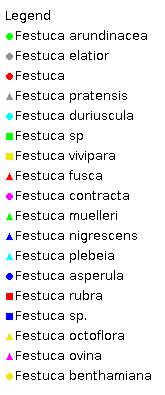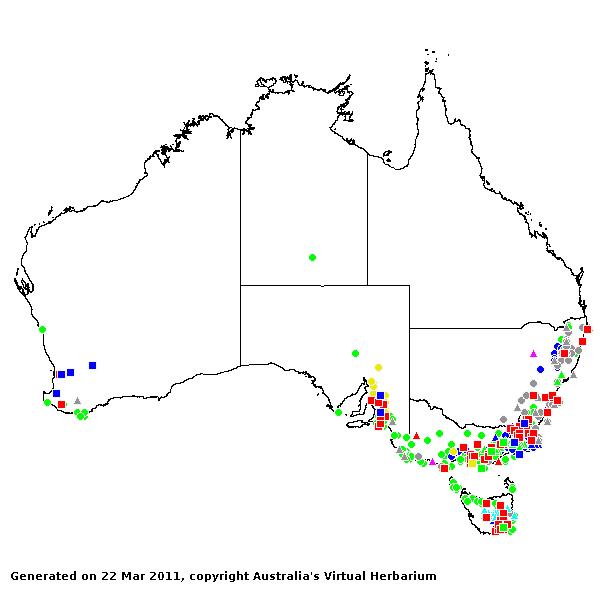Festuca Sp. Pl. 73 (1753).
Derivation:. Latin name for a weedy grass.
Taxonomic revisions, nomenclatural references:. J.W.Vickery, Contr. N.S.W. Nat. Herb. 1:5–15 (1939); E.B. Alekseev, Novit. Syst. Pl. Vasc. 24: 5–17 (1984).
Key references (keys and floras):. G.Bentham, Flora Australiensis 7: 662–664 (1878); C.A.Gardner, Flora of Western Australia 1 Gramineae 91–94 (1952); E.E.Henty, Manual Grasses New Guinea 104 (1969); J.C.Tothill and J.B.Hacker, Grasses of Southern Queensland 248–249 (1983); J.P.Jessop, Flora of South Australia 4: 1890–1891 (1986); B.K.Simon, Key to Australian Grasses 121–122 (1993); S.W.L.Jacobs and K.L.McClay, Flora of New South Wales 4: 608–611 (1993); N.G.Walsh, Flora of Victoria 2: 400–402 (1994); D.I.Morris, Student's Flora of Tasmania 4B: 194–198 (1994); E.Edgar and H.E.Connor, Flora of New Zealand 5: 96–124 (2000); D.Sharp and B.K.Simon, AusGrass (2002); J.P.Jessop, Grasses of South Australia 121–127 (2006); S.W.L.Jacobs, R.D.B.Whalley & D.J.B.Wheeler, Grasses of New South Wales, 4th ed, 266–269 (2008); A.Wilson (ed.), Flora of Australia 44A: Poaceae 2: 277–284 (2009).
W.D.Clayton & S.A.Renvoize, Genera Graminum (1986), genus (104).
Native and naturalised. 360 species (or more), from temperate regions and mountains worldwide. About 8 species in Australia, WA, SA, Qld, NSW, Vic, and Tas. Also New Guinea, Malesia and New Zealand.
Habit. Perennial, rhizomatous or stoloniferous or tufted or decumbent. Leaf blades narrow. Ligule an unfringed membrane (sometimes ciliolate).
Inflorescence. Inflorescence paniculate, an open panicle with branches ending in single spikelets, open (usually) or contracted (rarely).
Spikelets. Spikelets laterally compressed, more than 2 flowered, with 2 or more fertile florets, unawned or awned, solitary, pedicelled; with naked rachilla extension. Fertile spikelets disarticulating above glumes.
Glumes. Glumes unequal, shorter than spikelet, shorter than adjacent lemmas, pointed, awnless, keeled to non-keeled, similar (usually narrow to ovate-lanceolate). Lower glume 1–3 nerved. Upper glume (1–)3–5 nerved.
Florets. Fertile florets 2–14. Lemmas similar in texture to glumes to decidedly firmer than glumes, not becoming indurated, entire at apex or incised, when entire pointed or blunt, muticous or mucronate or awned, 3–7 nerved, hairy (rarely) or glabrous. Awns when present, 1, from a sinus or apical, non-geniculate, much shorter than body of lemma (usually) or about as long as body of lemma (sometimes, rarely somewhat longer). Palea relatively long, tightly clasped by lemma, apically notched, textured like lemma, 2 nerved. Distal incomplete florets underdeveloped. Lodicules 2. Stamens 3. Grain small or medium sized or large, fusiform or ellipsoid, longitudinally grooved, compressed dorsiventrally, with hairs confined to a terminal tuft. Hilum long-linear (usually about as long as the grain, but sometimes elliptical and only half as long). Embryo small.
Kranz Anatomy. C3.
2n = 14, 28, 35, 42, 56, and 70, 2, 4, 5, 6, 8, and 10 ploid, commonly adventive.
Habitat. Helophytic (rarely), mesophytic (mostly), xerophytic (rarely). Hillsides, mountains, plains, meadows.
Classification. Pooideae; Poeae.
Notes. A large and variable genus for which no world treatment is available. A key to 9 subgenera is given by Clayton and Renvoize (1986).
Types Species. F. ovina L.
Biogeographic Element. Clifford & Simon 1981, Simon & Jacobs 1990: Cosmopolitan.


